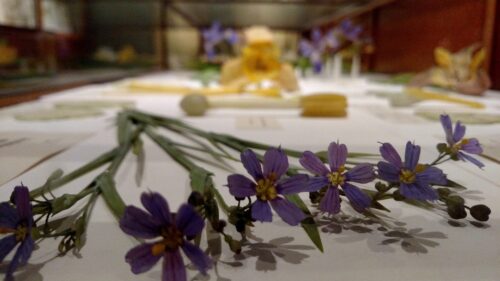An exploration of a soon-to-be-renovated exhibit.
When you enter the Harvard Museum of Natural History, everything is a little unassuming. Amazing things like rare fossils, precious stones, and the like—things usually presented in an imposing and impressive building—are found here with little fanfare. The museum exhibits are up three flights of stairs and nestled among dusty archives and labs, in low-ceilinged rooms flooded by warm sunlight on most afternoons. It’s through another unassuming door within the museum that you find yourself in a dimly lit room of wooden cabinets and glass boxes. But this room houses something amazing: the Ware Collection of Blaschka Glass Models of Plants, known more commonly as the Glass Flowers.
The story of the glass flowers begins in the early nineteenth century with Leopold Blaschka, who was born in Bohemia to a family of jewelers and glassmakers. Having developed a skill for manipulating glass with precision and great detail, Blaschka primarily made glass eyes and ornaments. His career found new inspiration in 1853 when he fell ill. Customs of the time dictated that a long sea voyage would help, so Blaschka sailed to the United States and back. It was during this time that Blaschka turned the focus of his artistry to the study and drawing of marine animals. This led him, upon his return, to recreate the animals in glass.
With the movement of his family to Germany, Leopold Blaschka continued to make glass models of living things. He recreated exotic flowers, catching the eye of Prince Camille de Rohan who then commissioned 100 orchids. Blaschka’s reputation for glass models quickly spread, and he began making models for museums, aquariums, universities, and other places of education.
In 1880, Leopold Blaschka’s son Rudolf began working with his father, and their business grew. The two created over 100 models of marine invertebrates for what is now the Boston Museum of Science, which in turn caught the eye of George Lincoln Goodale, a professor at Harvard. Goodale was a botanist in charge of founding and organizing the Harvard Botanical Museum as well as teaching new generations of botanists at the college. Without climate control, the harsh weather of Cambridge could not permit the viewing of live specimens year-round, and pressings or wax models lacked realism. Goodale thus commissioned the Blaschkas to create something better—the glass flowers.
From 1887 to 1936, Leopold and Rudolf Blaschka made glass flowers for Harvard. This was sponsored by the benefaction of Elizabeth C. and Mary Lee Ware 1834, who are the namesakes of the collection. Over 800 species are represented in the collection, which resides at Harvard today.
The fruits of the Blaschkas’ labor, including hundreds of models of everything from flowers to fruit, currently live in the Glass Flowers gallery. There are hundreds of flowers, of course, ranging from large blooms to tiny clusters of petals. Each pane of glass had to be heated and carefully shaped as it cooled; then, a thin wash of colored glass or metal oxides could be applied and fused to the glass. Most had wire supports placed inside the glass to reinforce the models, while others were blown, giving rise to hollow structures that mimic their delicate real-life counter-parts.
The remarkable range of techniques is evident in the wide range of plants that the Blaschkas were able to recreate. Some models show tiny root hairs almost as thin as strands of hair. Others have paper-thin ferns and leaves. And not all of the models are “pretty;” some show the effects of mold or fungus on apples or oranges, calling to mind the models’ educational intent. Walking through the gallery, it’s awe-inspiring to remember that all of them are made simply of silica.
All of the models are marked by small cards, giving the Latin and common names of each plant as well as its genus, family, and other facts. For example, you can find a model of the redroot, or New Jersey tea plant; its leaves were widely used for tea during the American Revolution. Elsewhere in the gallery, one can find Oryza sativa, or rice. The history—from the plants’ to the models’—intersects with the natural beauty and wonder of the glass, making the Ware Collection truly one of the most fascinating galleries in the Museum of Natural History.
The Glass Flowers exhibit will be closed from November 9, 2015 to May 21, 2016. A small selection of models will be available for viewing in the interim. As with all Harvard museums, admission is free with HUID for each student and one guest.
Audrey Effenberger ‘19 (effenberger@college.harvard.edu) thought the glass banana looked good enough to eat.

